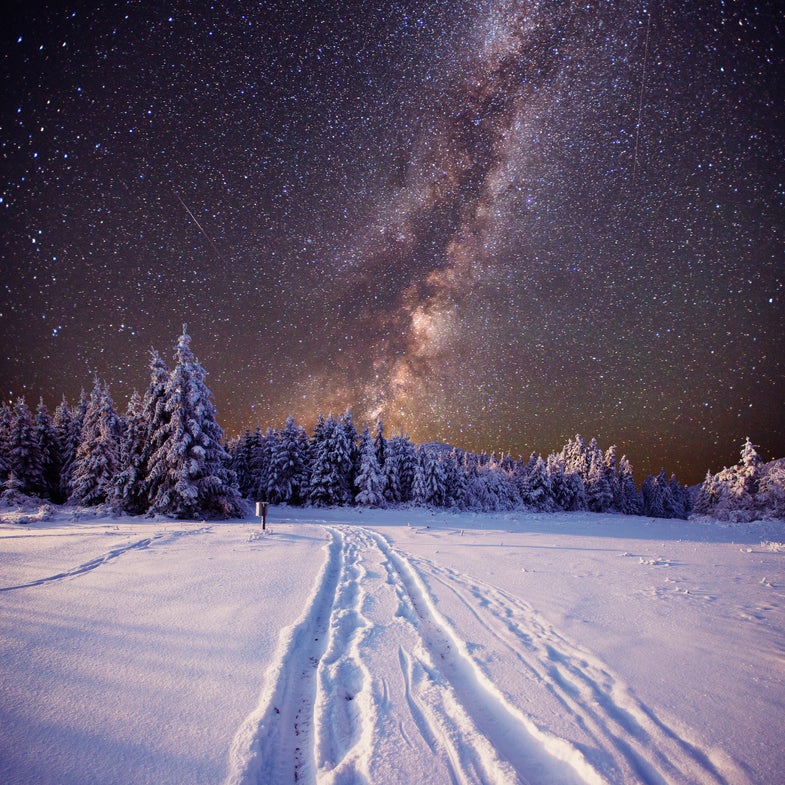How to watch a meteor shower like a pro
It doesn't take much to enjoy nature's fireworks.

A fragment of rock, ice, and metal travels through space along with other small bits of dust and debris, all excess weight shed by a comet as it made an ardent pilgrimage to the Sun.
Suddenly, the fragment gets a tug, pulled toward a new center. It rushes to its end, cruising through increasingly thick blankets of air until, overheated, it blazes brightly to life.
Did you see it? The traces a comet left behind? Watch carefully, because its companions are coming.
Meteor showers happen frequently, every time the Earth re-crosses a stream of cometary debris. The bright flashes of light don’t always hang heavy in the sky the way they do in pictures. They’re often quick, blink-and-they’re-gone lines easily mistaken for a star, an airplane, or a figment of your imagination. It takes patience to confirm with yourself that yes, you did really just see something from space fall through the sky. But then exhilaration takes over, as the shower reaches its peak and streak after streak light up the night.
The meteor shower will seem like it’s coming from one section of the sky, because the meteors are all headed the same direction when they encounter Earth. Major meteor showers are named after the constellations that they seem to come from (the Orionids for Orion, the Leonids for Leo, etc.)
November 17 and 18 mark the peak of the Leonids. And with a New Moon in the sky, this year is the perfect time to catch them.
We see many meteors from the @Space_Station but I was never able to get one on camera… this time I got lucky and filmed a #fireball, a very bright and fast meteoroid falling to #Earth at about 40km/s! Can you spot it? #VITAmission https://t.co/gbMuhPqbL8/ pic.twitter.com/YyZtUc22Oj
— Paolo Nespoli (@astro_paolo) November 16, 2017
You don’t need any special equipment to watch a meteor shower, but there are some steps you can take to make sure you’ll enjoy watching nature’s fireworks.
- When’s the next meteor shower?—The American Meteor Society keeps a calendar and detailed lists of meteor showers in a given year. They’ll tell you how many meteors you can expect to see per hour (they rarely happen all at once) and when the best time might be to head outside and view them.
- Find a dark place to watch the sky—If you’re serious about seeing this gorgeous space junk, the International Dark-Sky Association has a tool to help you find designated dark-sky areas close to where you live. It only lists officially recognized spots, but you can still have some luck on your own. Try to find an open space without a lot of trees or buildings blocking the horizon, far away from city lights. If your backyard fits the bill, turn off the lights in your home and embrace the darkness.
- Check the weather—Make sure you don’t have a major rainstorm moving in before you head outside. Optimists might decide that it’s worth waking up if the forecast calls for partly cloudy skies, but if it’s a monsoon outside, stay in and try for another night.
- Moon around—Don’t forget to check out where the Moon will be! While lovely, our satellite is a notorious light polluter, and its shine can wash out delicate meteor trails. If the Moon is new or a crescent, you’ll likely be ok. If it’s full, be sure to look at when it’s scheduled to set in your area. Hopefully it will disappear below the horizon before showtime. But even if it doesn’t, go outside and take a look. You may not see as many meteors as you would on a moonless night, but there’s still a chance.
- Set an alarm—Meteor showers tend to peak after midnight. Unless you’re a serious night owl who will be up at 3 a.m. regardless, go to bed as usual and set an alarm for the wee hours. Then wake up, make some coffee or hot cocoa, and drag your sleepy self outside.
- Get comfortable—You’re going to be outside for a while, as you’ll need to wait for your eyes to adjust and may spend even more time waiting for the shower to hit its peak. Dress for the weather, and bring some blankets to spread on the ground. It’s a great vantage point to watch the stars.
- No, really. No lights—Leave your cell phone inside. And if you have to use a flashlight to get to your favorite meteor-watching spot, turn it off as soon as you get settled. The light from your flashlight won’t obscure the sky, but it might obscure your vision. You may have to wait 20 to 30 minutes for your eyes to adjust. If you absolutely must use a light, try finding one with a red filter, which doesn’t mess with night-vision as much. Your eye has both rods and cones which allow you to see, and rods are more sensitive at night to pick up as much light as possible. But rods aren’t as sensitive to red light, making it a better choice for nighttime viewing.
And wanting to take a good photo for Instagram is no excuse to bring your way-too-bright phone to a viewing party. You know those shots are going to come out looking terrible anyway. If you’re interested in preserving your memories for the long haul. check out our guide for photographing a meteor shower here.